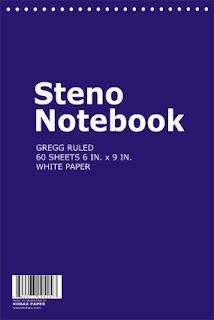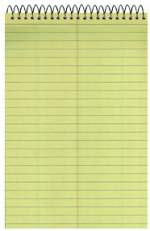
How many of y'all actually use a steno pad for its original purpose? Show of hands, please. Ah-ha. As I thought...I can count the number of you on one hand. Okay, put your hands down. For the unenlightened, here is your mini-lesson for today.
Back in the dark ages, also known as BPC (Before Personal Computers) there was this method of note-taking called "shorthand" and those of us who aspired to become secretaries (now known as administrative assistants) dutifully took classes in said shorthand because a)Out in the business world, your boss would dictate letters not into a machine of any form but...get this...to *you*! Gasp; b)It makes taking lecture notes much easier and faster (as long as you can transcribe what you wrote in a note-taking frenzy; c)You could write notes to your friends during classtime (did I say that? my bad) and anyone who didn't take shorthand couldn't decipher what you wrote should said note fall into the wrong hands.
Anyway, shorthand is a collection of nifty little symbols which stand for letters, sounds, words, or even phrases and, once you master the basics, it's pretty cool. Here's a little bit o'trivia - if you ever see a shorthand textbook and note the authors' names, you will see Gregg and Leslie. In fact, the books are usually entitled Gregg Shorthand. Well, my teacher in highschool was an ancient little old lady, Mrs. White, whose claim to fame was that Mr. Leslie was her teacher. (That and she used to sing Bye, Bye, Blackbird whilst illustrating some of the shorthand symbols on the blackboard, but let's not go there.)
 Okay, back to the whole steno pad topic. Upon observation, you will note that a steno pad has a red line that runs down the center of each page giving you two columns. Why? Here's where the shorthand origins come into play. In the left-hand column, you feverishly write all your nifty little squiggles, all the while hoping that you don't forget the symbol for something crucial and making up a bizarre new version. The right-hand column sits there, pristine and lonely until you find the time to (insert dramatic prairie dog music here) transcribe your notes. Painstakingly, you analyze all those little squiggles and write out in longhand what you think they mean right there in the column next door. It's best to do this whilst the dictation is fresh in your mind because, honestly, if you wait a few days, you are seriously going to wonder what the hell you were thinking when you made something up that looks like gibberish.
Okay, back to the whole steno pad topic. Upon observation, you will note that a steno pad has a red line that runs down the center of each page giving you two columns. Why? Here's where the shorthand origins come into play. In the left-hand column, you feverishly write all your nifty little squiggles, all the while hoping that you don't forget the symbol for something crucial and making up a bizarre new version. The right-hand column sits there, pristine and lonely until you find the time to (insert dramatic prairie dog music here) transcribe your notes. Painstakingly, you analyze all those little squiggles and write out in longhand what you think they mean right there in the column next door. It's best to do this whilst the dictation is fresh in your mind because, honestly, if you wait a few days, you are seriously going to wonder what the hell you were thinking when you made something up that looks like gibberish.Okie doke, now that you've had your mini-lesson on the original purpose of the steno pad (and, yes, there will be a pop-quiz next week) let me enlighten you as to a few of the many uses I have found in my post-shorthand classes world.
Phone messages - I developed this method whilst working at an engineering firm where I handled a great deal of the phone calls. At the start of the workday, I would note the day and date at the top of a clean page. Then incoming calls were noted this way: Left-hand column was for the incoming info: time of call, caller, company, reason for call. Skip a few lines and draw a line where the next message will begin. As time allows, do all the research for processing the first message and write down the notes in the right-hand column. When you call the person back, if that's the end of the issue, take a highlighter (not a marker) and draw a diagonal line through the left-hand column. This shows that you acted on the call but you can still read all your notes. If you want to be really creative, you can use a different colour highlighter for the company name so you can look up the info fairly easily if you have to go back and find it. On the cover of the steno pad, in bold fat marker, write the dates that the phone messages begin and end. Don't use the back side of the pages. Just end at the last page, date the book, and file it away.
To Do List - This is pretty much a no-brainer but I like to use both columns in a similar way to the phone messages. In the left column, I will note things that need to be done and in the right column I'll make any comments needed. I draw a line under the listing, such as: groceries - list everything - then draw a line; drug store - pick up rx - draw a line; Target - look for such-and-such - draw a line. I can look at my page and see that I need to go to three different places, not just one long list of things to do. Then, when I finish something entirely, I draw a diagonal line through it. If I don't get all the items at the grocery store, I can either highlight what's left or write it in the right-hand column. But I don't cross it off the list yet. I can easily see that I never did get that stupid shower curtain liner that I've been looking for. For those of us who need a little reinforcement that we actually do accomplish something every once in a while, it's satisfying to see all those things marked off...finally.
Oh, yes, here's something important that I must mention. When I choose a steno pad, I make sure I get one that has a very sturdy back cover. Why? Because I rubberband the pages out of the way when I am finished with them. A flimsy cover just won't hold the rubberband - it will try to bend and that's a royal pain. This way, you can close the pad and not lose your place. Sticky notes are fine on each page for little notes but don't rely on them to stick out to the side and remain intact when you shove your pad into a tote bag or briefcase. Yep, this is really high tech, folks. Steno pads and rubberbands - what will she think of next?
Okay, now to the knitting part of the steno pad adventure.
Knitting notes - When I design a pattern, I can write out directions as I go along in the (say it after me) left-hand column. (Good. You're catching on quickly) If I want to make comments, changes, any kind of notations - they go in the right column.
Knitting two of anything - This works for socks, gloves, mittens. As you keep track of rows knitted on the first of the pair, make all your notes in the left column. Then, when you make the second one, you note everything directly across from it, in the right column. IMPORTANT NOTE! When you are making a right and left handed anything and you need to differentiate for, let's say, the thumb placement, for heaven's sake please make a note of this somewhere in that right column or you will (voice of experience here) end up making two right gloves, mitts, whatevers. Trust me on this. I'm just sayin'.
Okay, that's enough for starters. I'd love to hear from y'all if you try out ye olde steno pad and come up with your own uses. There are all sorts of ostentatious organizers on the market and you can spend the big bucks trying to be cool with your leather-covered can't-live-without-it impress-the-higher-ups look-at-me...okay, you get the picture. But if you want to save some money and still be efficient, then why not?
I just came across a blog with a very cool post about creative use of a steno pad. Check this out.
Oh yeah, here's another little tip. Take a suitably sized envelope and tape it to the inside back cover of your steno pad. You can stick receipts, stamps, all kinds of little things there. Even index cards...ooooh, can I blog about them next?
What a great article on steno pads. It's delightful. Your shorthand teacher sounds wonderful. If you miss the stuff, there's a nice little Gregg Shorthand forum here: http://greggshorthand.multiply.com/
ReplyDeleteThanks for the tribute to shorthand!
I just realized you live in Snellville. Do you happen to teach shorthand? I'm just around the corner. I don't see a way to send a message to you here. If you do teach, or would teach Gregg, could you pop in at the Gregg Shorthand Forum and say "hello"? I'm Shorthandlearner over there.
ReplyDeleteThanks!